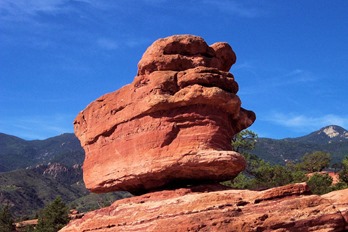Until we visited it in 2004, I had no idea that Garden of the Gods was a Colorado Springs city park. Most large cities have some nice parks, but few have parks with outstanding geologic features like Garden of the Gods.
We visited the park again this year.
Garden of the Gods Park started with a gift from the family of Charles Elliott Perkins, a former president of the Chicago, Burlington, and Quincy Railroad. Perkins had purchased 480 acres of the current park for a summer home that was never built. He died in 1907 with his children aware of his wish for the public to be able to enjoy the natural wonder.
A plaque in the park reads, “The Garden of the Gods. Given to the City of Colorado Springs in 1909 by the children of Charles Elliott Perkins in fulfillment of his wish that it be kept forever free to the public.”
Source of the name “Garden of the Gods” –
The name of the park dates back to August 1859 when two surveyors helping to set up nearby Colorado City were exploring the nearby areas. Upon discovering the site, one of the surveyors, M. S. Beach, suggested that it would be a “capital place for a beer garden.” His companion, the young Rufus Cable, awestruck by the impressive rock formations, exclaimed, “Beer Garden! Why it is a fit place for the gods to assemble. We will call it the Garden of the Gods.” The beer garden never materialized, but the name stuck. –Wikipedia
Geologic formations –
The outstanding geologic features of the park are the ancient sedimentary beds of red, blue, purple, and white sandstones, conglomerates and limestone that were deposited horizontally, but have now been tilted vertically and faulted by the immense mountain building forces caused by the uplift of the Pikes Peak massif. Evidence of past ages; ancient seas, eroded remains of ancestral mountain ranges, alluvial fans, sandy beaches and great sand dune fields can be read in the rocks. A spectacular shear fault can be observed where the Tower of Babel (Lyons Sandstone) contacts the Fountain Formation. There are many fossils to be seen: marine forms, plant fossils, and some dinosaur fossils.
The hogbacks, so named because they resemble the backs and spines of a pig, are ridges of sandstone whose layers are tilted. Instead of lying horizontally, some layers are even vertically oriented. Each hogback can range up to several hundred feet long, and the tallest (called North Gateway Rock) rises to a height of 320 feet (98 m) tall. A notable rock feature on this hogback, the Kissing Camels, appears to be two very large camels sitting face to face with their lips touching. –Wikipedia
Links:


